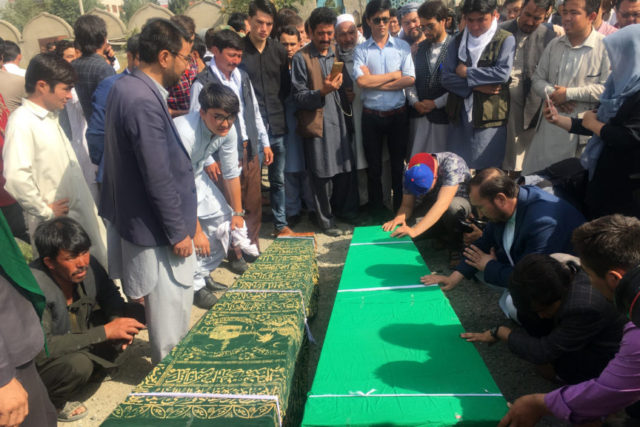KABUL, Afghanistan (AP) — As Afghanistan’s Shiites mourned their dead and held funeral services on Friday, the Islamic State affiliate claimed responsibility for the horrific suicide bombing the previous day in Kabul that targeted a Shiite neighborhood, killing 34 students.
Grieving families gathered to bury their dead but even amid the somber atmosphere there was no respite from violence.
Gunmen besieged a compound belonging to the Afghan intelligence service in a northwestern Kabul neighborhood early Thursday, opening fire as Afghan security forces moved in to cut them off. The Islamic State group, in a posting on its Aamaq News Agency, claimed more than 200 people were killed or wounded in Wednesday’s attack.
The bomber, who had walked into a classroom in a one-room building at a Shiite educational center in the neighborhood of Dasht-e-Barchi, where he set off his explosives, was identified as “the martyrdom-seeking brother Abdul Raouf al-Khorasani.” Afghanistan’s IS affiliate is known as The Islamic State in Khorasan Province, the ancient name of an area that encompassed parts of present-day Iran, Afghanistan and Central Asia.
The bombing also wounded 57 students, according to Health Ministry spokesman Wahid Majroh. Earlier on Thursday, the ministry revised an earlier death toll from the attack down to 34, not 48.
Most of the victims were young men and women, high school graduates preparing for university entrance exams in the Shiite area’s educational center. Authorities launched an investigation to determine how the bomber had managed to sneak into the compound in the neighborhood, which has its own guards.
Kabul hospitals were completely overwhelmed in the immediate aftermath of the attack as officials collected data on the casualties, leading to the confusion and the initial wrong toll.
The Dasht-e-Barchi area is populated by members of Afghanistan’s minority ethnic Hazaras — a Shiite community that has in the past been targeted by similar large-scale attacks.
The Islamic State group, which considers Shiites to be heretics, frequently targets them, attacking their mosques, schools and cultural centers. In the past two years, there have been at least 13 attacks on the Shiite community in Kabul alone.
Fifteen of the victims’ bodies were taken Thursday to a Hazara community compound in Kabul where a mass funeral service was being held. The remaining victims will be taken to their villages to be buried there, said Gulam Hassan, the cousin of one of the victims.
The attacks, which come at the end of more than a week of assaults that have left scores of Afghan troops and civilians dead, show how militants are still able to stage large-scale attacks — even in the capital of Kabul — and undermine efforts by Afghan forces to provide security and stability on their own.
Afghan President Ashraf Ghani has condemned the “terrorist” attack on the Shiite center in Kabul that “martyred and wounded the innocent” — students attending class — and ordered an investigation into the attack.
In a Kabul hospital on Thursday, Anifa Ahmadi sat by the bedside of her 17-year-old daughter Sima, who was wounded in the suicide bombing.
Sima was in the front row of the classroom in the single-room building where the explosion occurred.
“I had told her and told her, ‘Don’t go to school. We are under attack everywhere. No place is safe for us.’ But she said ‘No, no, no’,” the mother said.
Sima appeared undeterred despite injuries to her legs and arms and said she would go back to school. “I won’t let anyone stop me, I will resist all terrorist attacks to have the future I want,” she said.
Nahida Rahimi, a doctor at Kabul’s Isteqlal Hospital, where some of the wounded are being treated, said a mother told her she had lost a son in Wednesday’s bombing after already losing another a year earlier in another suicide bombing, also in Kabul, that targeted Shiites.
“We were both crying,” the doctor said.
Meanwhile, police officer Abdul Rahman told The Associated Press from the location of the morning siege in Kabul that the gunmen were holed up in a partially constructed building near the compound from where they were opening fire.
The shooting — which underscored the near-daily, persistent threats in war-battered Afghanistan — was sporadic and it wasn’t immediately clear how many gunmen are involved in the assault. Afghan security personnel have surrounded the building and have the situation under control, he said.
Kabul’s police spokesman, Hashmat Stanekzi, said there were no immediate reports of casualties.

COMMENTS
Please let us know if you're having issues with commenting.